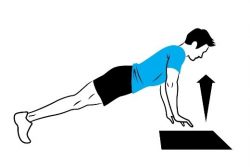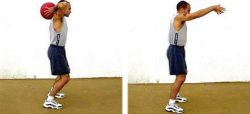What is it?
Plyometric training is basically ‘jump training’. It involves high intensity explosive movements where muscles exert maximum force in short intervals of time, with the goal of increasing power – a combination of strength and speed. This training focuses on moving from a muscle extension to a contraction in a rapid or “explosive” manner, to make the maximise the elastic properties of the major muscles in a ‘stretch, shortening cycle’.
How does it work?
Think about when you stretch an elastic band and it snaps back with more force than when it was slack. Our muscles do the same thing. Try jumping up in the air as high as you can. Notice how you naturally drop down into a full squat and explode up quickly?
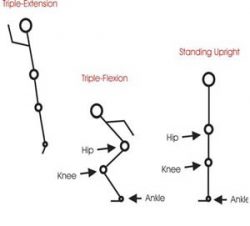 Now think about if you hold an elastic band in a stretched position for a long time – it starts to lose some of it’s ‘snap’. Try jumping again but this time pause at the bottom of your squat for 5 seconds before jumping up. The longer you sit down in that squat position, the more you LOSE that elastic energy. Plyometrics is all about a QUICK change from stretch to contract.
Now think about if you hold an elastic band in a stretched position for a long time – it starts to lose some of it’s ‘snap’. Try jumping again but this time pause at the bottom of your squat for 5 seconds before jumping up. The longer you sit down in that squat position, the more you LOSE that elastic energy. Plyometrics is all about a QUICK change from stretch to contract.
True Plyometrics was originally used by the Soviet Olympians in the 1970s and was focused on the lower body using a variety of jumps, particularly focused on the depth jump – jumping down off a box and then absorbing the ‘shock’ of landing and immediately jumping back up, to replicate the forces encountered in high intensity athletics.
We can apply the same principles to train plyometrically for the upper body as well by performing explosive pushups, pullups or using weighted balls for throwing and catching.
Who does it work for?
Plyometrics is very high impact and high intensity so it is better suited to certain people:
GOOD for
- Athletes playing high impact sports involving running, jumping, kicking and throwing
- Increasing the challenge if you are already fit and healthy
- Advanced level training
NOT recommended for
- Beginners
- Pregnancy
- Anyone succeptible to breaks, slips or falls
- Anyone with a current injury to ankles, knees, hips or spine
Is it useful for general fitness training if you’re not an athlete?
YES! Because of their high intensity, plyometric exercises burn a lot of calories and elevate the heart rate, they can be used in high intensity interval training (HIIT) sessions or tabata sessions, which make your workouts shorter and more efficient. Higher intensity = less time needed. You can throw one or two plyometric moves into your usual workout, or you can go all out and plan a full plyometric circuit.
Try the following movements, alternate between upper and lower body, and time yourself for 30 seconds or 10 reps of each exercise with 30 seconds in between. It will only take you 10 minutes to get through the complete circuit once, and if you want to go through it twice, you’re still going to be done in just 20 minutes!
| Lower Body Plyometrics | Upper Body Plyometrics |
Squat jump – Squat down then jump off the ground as high as possible, with extended and vertical legs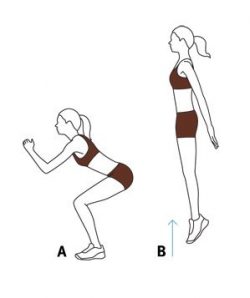 |
Plyometric push up – perform a push up, but exert enough upward force to lift the hands and body off the ground.
|
Tuck jump – with feet shoulder width apart, jump, tuck the legs in right up to the chest if possible, extend them, and land.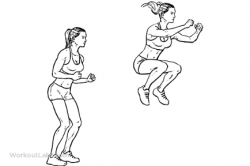 |
Med ball chest passes – Stand in a neutral stance facing a wall with the medicine ball at your chest. Strongly push the ball away from you at a wall so that it bounces back to you. Catch and immediately throw the ball back at the wall. 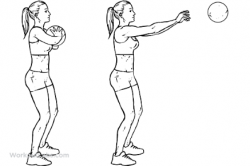 |
Lateral jump – from a standing position, jump side to side with both feet, similar to a skier hopping over moguls 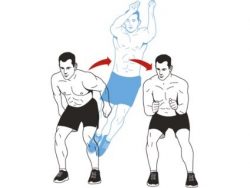 |
Kneeling side toss – Position yourself sideways next to a wall, in a half-kneeling position. Holding a medicine ball in front, rotate your torso slightly away from the wall and then immediately towards the wall as you throw the ball forcefully enough to have it returned to you.  |
Box jumps – jump onto and off of a large box. You can jump up forwards and down backwards, or you can jump up and then over forwards and turn around and repeat. 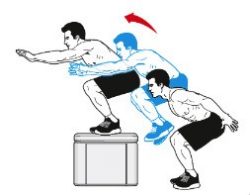 |
Overhead Forward Throw – Start in a neutral stance, with your feet slightly wider than your hips. Hold a medicine ball overhead, lower the ball slightly behind your head and throw the ball forcefully at the wall. The ball should rebound back into your hands overhead. Immediately catch and then throw the ball back at the wall.
|
Broad jump – From a standing position, swing your arms, and explode from your legs to jump as far forward as possible. 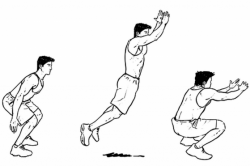 |
Slams – Stand with feet parallel, shoulder-width apart and knees slightly bent. Pull medicine ball back behind head and forcefully throw ball down on the ground as hard as possible. Catch the ball on the bounce from the ground and repeat. 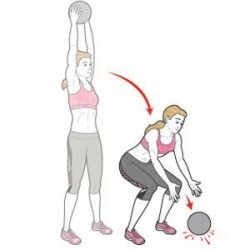 |

